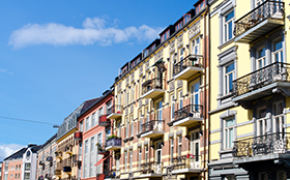Decrease in interest payments, but increase in debt for home owners
Published:
Interest payments on home loans have decreased since 2012, but the home loan debt has increased. Families with children have the largest yearly housing costs. However, the housing costs of single parents and one-person households are most burdensome.
- Full set of figures
- Housing conditions, survey on living conditions
- Series archive
- Housing conditions, survey on living conditions (archive)
Norwegian households’ average total housing costs is NOK 96 000 per year. The housing costs are highest in the big cities, where the average is NOK 106 000, and lowest in sparsely populated areas, where the average is NOK 84 000, according to the results of the Survey of Living Conditions 2018.
Figure 1. Total housing costs, by tenure status and year. 2012-2018. (adjusted for inflation) Households
| 2012 | 2015 | 2018 | |
| In total | 105010 | 101476 | 95762 |
| Owners (freeholder) | 112389 | 106764 | 99678 |
| Owners (shareholder) | 107424 | 106000 | 95722 |
| Tenants | 82382 | 85505 | 86648 |
Decrease in total housing costs for owners, increase for tenants
Three quarters of Norwegian households own their dwelling. Interest rates have been very low for several years. The numbers from the Survey of Living Conditions show that the total housing costs for owners have decreased, and that a large share of the decrease is caused by reduced payments of interest for home loans. Owners paid a yearly average of NOK 40 000 in interest in 2012, whereas the payments are NOK 29 000 on average in 2018.
Even though the debt growth has slowed, owners’ average debt has been increasing since 2012. Owners had an average of NOK 1 million in debt in 2012, compared to an average of NOK 1.2 million in 2018. The increase in debt is largest in the big cities. The house sales price estimated by owners has increased from NOK 3.5 million in 2012 to NOK 4 million in 2018. The price index for existing dwellings also shows an increase in housing prices in the same period.
One quarter of Norwegian households rent their dwelling. The tenants have experienced an increase in their total housing costs since 2012 due to higher rents. Tenanted households paid an average of NOK 70 000 in rent in 2012, compared to NOK 77 000 in 2018.
Couples with children spend most on their dwelling
Large households have higher total housing costs than small households. Couples with young children (aged 0-6 years) have the highest costs. On average, these households spend NOK 141 000 yearly on housing costs. Couples with school-aged children (aged 7-19 years) and single parents also spend more on housing costs than the national average, with NOK 131 000 and NOK 118 000 respectively.
Young couples without children also spend more than the national average, at NOK 116 000 per year. The fact that such couples are often starting their working life, setting up home for the first time and living in big cities are possible explanations for their spending being higher than any other couples without children. Single-person households and elderly couples have the lowest total housing costs, ranging from NOK 62 000 to NOK 85 000 on average.
Figure 2. Total housing costs, by household type. 2018. Households
| Total housing costs in NOK | |
| Couples with children ageing 0 - 6 | 140956 |
| Couples with children ageing 7 - 19 | 130663 |
| Single parents with children ageing from 0 - 19 | 117678 |
| Young couples with no children, 16-44 years | 115584 |
| Mid- aged couples with no children, 45-66 years | 97153 |
| Not classified, others | 94792 |
| Couples with children ageing 20+ | 88077 |
| Single people aging from 16 - 44 | 85247 |
| Mid- aged singles 45-66 years | 81633 |
| Elderly couples with no choldren, 67 years and more | 73699 |
| Elderly singles 67 years and more | 61685 |
Single parents and single-person households are burdened the most by their housing costs
Even though couples with children are the households with the highest housing costs, they do not perceive their costs as more burdensome than the national average. Five per cent of couples with small children, and 2 per cent of couples with school-aged children find the costs very burdensome, compared to the national share of 5 per cent. This can be viewed in relation to the average income of these households, which is higher than for smaller households, and the fact that large households benefit more due to the economies of scale.
Figure 3. Share of households that experience their housing costs as very burdensome. 2018. Households
| Share of households experiencing housing costs as very burdensome | |
| Single parents with children ageing from 0 - 19 | 10 |
| Single people aging from 16 - 44 | 9 |
| Mid- aged singles 45-66 years | 8 |
| Not classified, others | 7 |
| Couples with children ageing 0 - 6 | 5 |
| Young couples with no children, 16-44 years | 5 |
| Elderly singles 67 years and more | 3 |
| Couples with children ageing 7 - 19 | 2 |
| Couples with children ageing 20+ | 2 |
| Mid- aged couples with no children, 45-66 years | 1 |
| Elderly couples with no choldren, 67 years and more | 1 |
One in ten single-person households and single-parent households perceive their housing costs as very burdensome, which is twice as many as the national share. This might be because these household types have lower average income than households made up of couples.
Middle-aged and elderly couples without children perceive their housing costs as least burdensome. One per cent of these households perceive their total housing costs as very burdensome.
Contact
-
Mathias Killengreen Revold
-
Kristina Strand Støren
-
Statistics Norway's Information Centre


